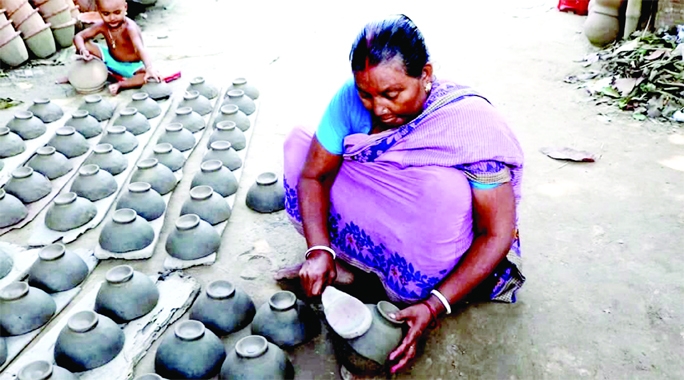
Ishwardi (Pabna) Correspondent :
The traditional pottery of Bengali is now on the verge of extinction. With the touch of modernity, the demand for the pottery has decreased in the cities as well as in the villages. As a result, the people of the Pal community involved in this industry have become disoriented. Many have already changed careers. The busyness that used to be seen in Palpara is no longer there. Rows of clay pots are not so noticeable anymore. As the demand for earthenware is not as before, its place has been taken by zinc, aluminum and plastic utensils.
Potters used to make curd pots, pithakholas, rice pots, pot lids, curry pots, juice pots, incense pots, mud pots, lamp pots, water pots for children using only dry straw, wood, clay, sand and water. Different types of clay toys. But with the passage of time, the demand for earthenware has decreased as the use of bahari design plastic, melamine, steel, electric rice cooker, ceramic and silverware has increased. Due to which the scope of work of the people involved in this industry has decreased on the one hand, as well as the income has decreased. Forced to make a living, many people now leave the profession of their parents and engage in other professions. Some of the current generation of potters have changed their profession and taken up small businesses like driving rickshaws, vans, auto rickshaws.
Due to scarcity of land and increase in fuel prices, the people of the Pala community associated with this industry are disoriented. About three hundred Pal families were associated with pottery in Muladuli of Iswardi upazila and Arambaria of Sara union.
Hundreds of families are still associated with this profession. He has been supporting his livelihood and children’s education by sheltering this profession.
As can be seen in Palpara on the surface, some families still hold this art of their fathers and grandfathers. Someone is making curd bottles. Someone is working in the kiln to burn pots and pans. And the women and children of the family are helping the men in all kinds of work, including drying the yogurt bottles in the sun.
Ravi Pal said that the price of each bag of powder has been Tk 150. The prices of cow dung fuel and paddy straw have also increased more than before. Overall, the cost of production is increasing, but the demand for our manufactured goods is decreasing. He also said that if financial assistance is provided from public-private support organizations to keep the traditional pottery industry alive, then it will be possible to save this industry from extinction.
Sudev Chandra Pal, a potter, said that the pottery has almost stopped. Yoghurt bottles and toilet paper are now a bit old. A small number of families now sustain the pottery industry. Running a family is difficult. Those of us who are with this work, our lives are going through a kind of suffering.
UNO saidd that there is no opportunity for government support to sustain the potters. However, if they contact various associations and training in youth development, low interest loans can be arranged.

